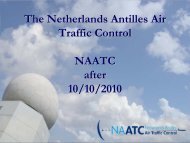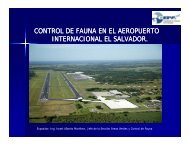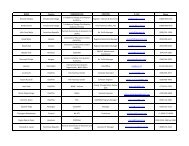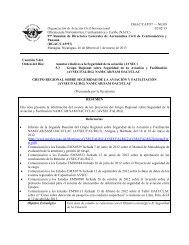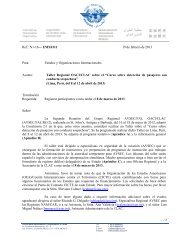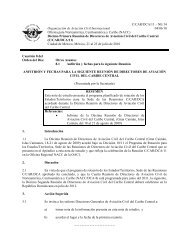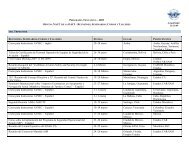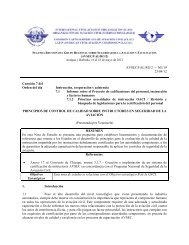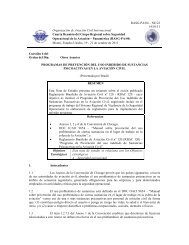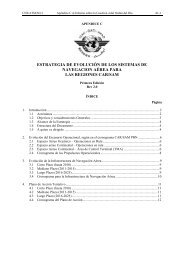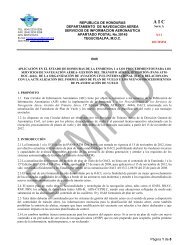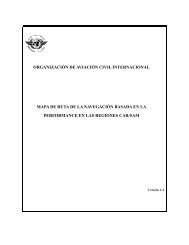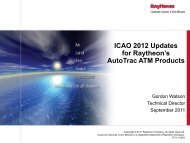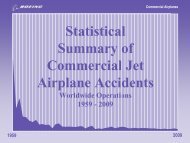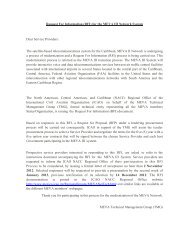ADS-B and WAM implementation Workshop ICAO/FAA
ADS-B and WAM implementation Workshop ICAO/FAA
ADS-B and WAM implementation Workshop ICAO/FAA
You also want an ePaper? Increase the reach of your titles
YUMPU automatically turns print PDFs into web optimized ePapers that Google loves.
<strong>ADS</strong>-B <strong>and</strong> <strong>WAM</strong> <strong>implementation</strong> <strong>Workshop</strong> <strong>ICAO</strong>/<strong>FAA</strong><br />
EXPERIENCE ON INSTALLATION OF <strong>ADS</strong>-B<br />
SENSOR AT MEXICO CITY AIRPORT<br />
México, DF. September 6th th th to 8th 2011
<strong>ADS</strong>-B <strong>and</strong> <strong>WAM</strong> <strong>implementation</strong> <strong>Workshop</strong> <strong>ICAO</strong>/<strong>FAA</strong><br />
INTRODUCTION<br />
• Accomplish the surveillance cover over mexican air<br />
space<br />
• Increase safety for aeronautical operations in APP<br />
areas iin MMexico i<br />
• <strong>FAA</strong> <strong>and</strong> SENEAM working together for <strong>ADS</strong>-B on<br />
<strong>FAA</strong> <strong>and</strong> SENEAM working together for <strong>ADS</strong> B on<br />
Gulf of Mexico Project
<strong>ADS</strong>-B <strong>and</strong> <strong>WAM</strong> <strong>implementation</strong> <strong>Workshop</strong> <strong>ICAO</strong>/<strong>FAA</strong><br />
Accomplish the surveillance cover over mexican air space
<strong>ADS</strong>-B <strong>and</strong> <strong>WAM</strong> <strong>implementation</strong> <strong>Workshop</strong> <strong>ICAO</strong>/<strong>FAA</strong><br />
Accomplish the surveillance cover over mexican air space
<strong>ADS</strong>-B <strong>and</strong> <strong>WAM</strong> <strong>implementation</strong> <strong>Workshop</strong> <strong>ICAO</strong>/<strong>FAA</strong><br />
Increase safety for aeronautical operations in APP<br />
areas in Mexico
<strong>ADS</strong>-B <strong>and</strong> <strong>WAM</strong> <strong>implementation</strong> <strong>Workshop</strong> <strong>ICAO</strong>/<strong>FAA</strong><br />
<strong>FAA</strong> <strong>and</strong> SENEAM working together for <strong>ADS</strong>-B on<br />
Gulf of Mexico Proyect<br />
December 2009<br />
Expectation
<strong>ADS</strong>-B <strong>and</strong> <strong>WAM</strong> <strong>implementation</strong> <strong>Workshop</strong> <strong>ICAO</strong>/<strong>FAA</strong><br />
<strong>FAA</strong> <strong>and</strong> SENEAM working together for <strong>ADS</strong>-B on Gulf of<br />
Mexico Project<br />
December2009<br />
Expectation
<strong>ADS</strong>-B <strong>and</strong> <strong>WAM</strong> <strong>implementation</strong> <strong>Workshop</strong> <strong>ICAO</strong>/<strong>FAA</strong><br />
<strong>FAA</strong> <strong>and</strong> SENEAM working together for <strong>ADS</strong>-B on<br />
Gulf of Mexico Project<br />
• The st<strong>and</strong>ard separation between two aircraft same bound, same<br />
Flight Level is set on the Letter of Agreement HOU – MID:<br />
– 10 minutes i if MMach h technique h i iis<br />
set.<br />
– 15 minutes if No Mach technique is used.<br />
• On the LOA between MID <strong>and</strong> HAV:<br />
– 40 Nautical Miles<br />
• On the LOA between MID <strong>and</strong> CENAMER:<br />
– 40 Nautical Miles Miles. On continental area area.<br />
– 10 minutes if Mach technique is set.
<strong>ADS</strong>-B <strong>and</strong> <strong>WAM</strong> <strong>implementation</strong> <strong>Workshop</strong> <strong>ICAO</strong>/<strong>FAA</strong><br />
<strong>FAA</strong> <strong>and</strong> SENEAM working together for <strong>ADS</strong>-B on<br />
Gulf of Mexico Project
<strong>ADS</strong>-B <strong>and</strong> <strong>WAM</strong> <strong>implementation</strong> <strong>Workshop</strong> <strong>ICAO</strong>/<strong>FAA</strong><br />
<strong>FAA</strong> <strong>and</strong> SENEAM working together for <strong>ADS</strong>-B on<br />
Gulf of Mexico Project
<strong>ADS</strong>-B <strong>and</strong> <strong>WAM</strong> <strong>implementation</strong> <strong>Workshop</strong> <strong>ICAO</strong>/<strong>FAA</strong><br />
<strong>FAA</strong> <strong>and</strong> SENEAM working together for <strong>ADS</strong>-B on<br />
Gulf of Mexico Proyect
Test site location<br />
<strong>ADS</strong>-B <strong>and</strong> <strong>WAM</strong> <strong>implementation</strong> <strong>Workshop</strong> <strong>ICAO</strong>/<strong>FAA</strong><br />
<strong>ADS</strong>-B Test Implementation<br />
Peñon radar site was selected to set an <strong>ADS</strong>-B equipment. PSR radar is located<br />
top on hill near by Mexico City International Airport “Benito Juárez”<br />
The <strong>ADS</strong>-B equipment <strong>and</strong> its RCMS was connected to test processing platform<br />
(EUROCAT-X)
<strong>ADS</strong>-B <strong>and</strong> <strong>WAM</strong> <strong>implementation</strong> <strong>Workshop</strong> <strong>ICAO</strong>/<strong>FAA</strong><br />
What are we looking for test site<br />
<strong>ADS</strong>-B Test Implementation<br />
Peñon site is a very important surveillance point by its geographical<br />
position on the city, in fact it is a militar security area. The Valley of<br />
MMexico i iis perfectly f tl covered d bby <strong>ADS</strong> <strong>ADS</strong>-B B antenna t pattern. tt Mexico M i City Cit<br />
International Airport is inside of this area.
<strong>ADS</strong>-B <strong>and</strong> <strong>WAM</strong> <strong>implementation</strong> <strong>Workshop</strong> <strong>ICAO</strong>/<strong>FAA</strong><br />
<strong>ADS</strong>-B Test Implementation<br />
Operational importance of Peñon Radar Station<br />
The Mexico City International Airport <strong>and</strong> its terminal area has the<br />
greater number of operations in Mexico. It is considered one of the most<br />
complex p operational p area. The complexity p y is increased by y the elevation<br />
of the city, by the mountains around it <strong>and</strong> because the city is one of the<br />
most heavily populated on the world.
<strong>ADS</strong>-B Equipment<br />
<strong>ADS</strong>-B <strong>and</strong> <strong>WAM</strong> <strong>implementation</strong> <strong>Workshop</strong> <strong>ICAO</strong>/<strong>FAA</strong><br />
-THALES Ground Station AS680<br />
<strong>ADS</strong>-B Test Implementation<br />
Signal Processing Unit (SPU)<br />
GPS RX antenna<br />
<strong>ADS</strong>-B RX antenna with Antenna Amplifier Unit (AAU)<br />
-Communications<br />
-PROXIM Radio enlace LAN TSUNAMI MP-850 CPE
<strong>ADS</strong>-B <strong>and</strong> <strong>WAM</strong> <strong>implementation</strong> <strong>Workshop</strong> <strong>ICAO</strong>/<strong>FAA</strong><br />
<strong>ADS</strong>-B<br />
Radars<br />
<strong>WAM</strong><br />
<strong>ADS</strong>-B Test Implementation<br />
MEDISIS<br />
SNMAP<br />
FDP<br />
Radars RDP<br />
Cat 09 Weather messages<br />
Cat 01 plot<br />
Cat 30 ACC multi-sensor surveillance track<br />
Cat 30 APP multi-sensor surveillance track<br />
CDC Local track<br />
Cat 09 Weather messages<br />
Cat 30 ACC multi-radar surveillance track<br />
Cat 30 APP mono-radar surveillance track<br />
H<br />
M<br />
I
A<br />
S<br />
<strong>ADS</strong>-B <strong>and</strong> <strong>WAM</strong> <strong>implementation</strong> <strong>Workshop</strong> <strong>ICAO</strong>/<strong>FAA</strong><br />
<strong>ADS</strong>-B Test Implementation on the<br />
Processing Platform<br />
Fusion<br />
Visu 01 DBM<br />
Visu 02<br />
RBP<br />
Database
<strong>ADS</strong>-B <strong>and</strong> <strong>WAM</strong> <strong>implementation</strong> <strong>Workshop</strong> <strong>ICAO</strong>/<strong>FAA</strong><br />
Tests<br />
The <strong>ADS</strong>-B equipment was setted taking account the GPS position <strong>and</strong> the<br />
information was integrated to Special Fusion Equipment in a Processing<br />
System. This equipment mix the radar data with <strong>ADS</strong>-B data for delivering<br />
one fusioned track.<br />
Once the system was ready ready, an analysis was done over data data, checking <strong>ADS</strong>-<br />
B perfomance. The <strong>ADS</strong>-B aircraft was located over the airway perfectly,<br />
every second. The accurated was increase <strong>and</strong> it is better than SSR data.<br />
In spite of the air traffic is dense over the terminal area, 20% of aircraft was<br />
detected with <strong>ADS</strong>-B transponder on board only.
<strong>ADS</strong>-B <strong>and</strong> <strong>WAM</strong> <strong>implementation</strong> <strong>Workshop</strong> <strong>ICAO</strong>/<strong>FAA</strong><br />
Conclusion<br />
• 20% of aircaft l<strong>and</strong>ing on Mexico City Intanational Airpot has <strong>ADS</strong>-B<br />
transponder on board.<br />
• It is necessary y to emit a m<strong>and</strong>atory y rule about the installation of <strong>ADS</strong>-B<br />
transponder on every aircraft if they will be l<strong>and</strong>ing on this airport.<br />
• Install MLAT before <strong>ADS</strong>-B ground station, could be a good solution<br />
while aircrafts are fitted with avionics appropiate (transition time).<br />
• MLAT / <strong>ADS</strong>-B base ground could be installed in the terminal areas<br />
with a great number of operation as MEX, CUN, GDL, MTY, HMO<br />
• <strong>ADS</strong>-B base ground could be installed through coast of Gulf of México<br />
(TAM, VER, VSA) to acomplish the surveillance cover between ACC<br />
MID <strong>and</strong> HOU.



